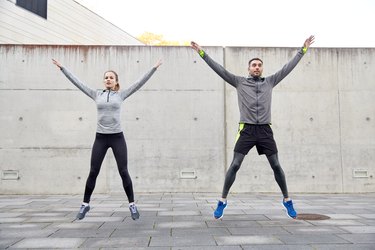
If you show up early enough to a sporting event, you might see the participants performing jumping jacks, either collectively or individually, as part of their pregame routine.
The exercise, which involves spreading your arms and legs like a starfish — then jumping them back together — increases your heart rate, stimulating blood flow to a variety of muscle groups throughout your body. Learning these jumping jacks muscle groups will help you determine the activities for which the jumping jack may be an effective warm-up exercise.
Video of the Day
Video of the Day
Read more: Benefits of Jumping Jacks
Tip
Jumping jacks work muscles throughout your arms, legs and core. As an added benefit, they also boost cardio health.
Calves and Core
The gastrocnemius and soleus muscles make up the calves, spanning the back of your lower legs. The muscles attach near the knee joint on top and combine at the Achilles tendon to attach to the heel on the bottom. They cooperate to plantarflex your ankle, which is the movement that lifts your heel off the floor. The calf muscles contract every time you jump when performing jumping jacks and again each time you land to soften the impact between your feet and the floor.
As with most athletic activities, your core muscles help stabilize your movements throughout the jumping jack exercise, and also help maintain your balance. Core muscles that assist you during jumping jacks include your abs — the rectus and transversus abdominis, and the obliques — hip flexors such as the psoas major and lower-back muscles such as the lower portion of the erector spinae.
Read more: A 10-Minute Plyo Box Leg-Day Workout
Abduct and Adduct Your Hips
The gluteus medius muscle is the primary hip abductor, allowing you to spread your legs apart when you perform jumping jacks, and the gluteus minimus assists. These are two of the three muscles often referred to as the buttocks, or glutes. Both of these muscles attach to the ilium located on the pelvis on one end and the greater trochanter, the bony protrusion on the outside of your hip on the other end.
The hip adductors include four muscles that that cross the inside of your hip joint: the adductor brevis, adductor longus, adductor magnus and gracilis. Each of these muscles attaches to your pelvis and the inside of the femur, or thigh bone, on the bottom except the gracilis, which attaches to the inside of the tibia bone, just below your knee, instead of the inside of your thigh. These muscles cooperate to bring your legs back together during the return phase of the jumping jack exercise.
Arm Abduction and Adduction
The middle portion of the deltoid and the supraspinatus muscles work together to abduct your shoulder joint, moving your arm sideways away from your body. The former muscle attaches to the top of the acromion, just above your shoulder joint, on one end and to the top outside portion of the humerus bone of your upper arm on the other. The latter muscle follows a similar path.
These muscles contract to arc your arms from your sides over your head during the initial phase of the jumping jack exercise at the same time that you're spreading your legs apart.
The shoulder adductors come into play as you lower your arms to your sides. A variety of muscles across your upper chest, back and arms act as shoulder adductors, including the latissimus dorsi and teres major in your back, both heads of the pectoralis major in your chest, the triceps in your upper arms and the coracobrachialis in your shoulders.
Was this article helpful?
150 Characters Max
0/150
Thank you for sharing!
Thank you for your feedback!